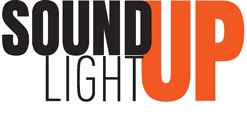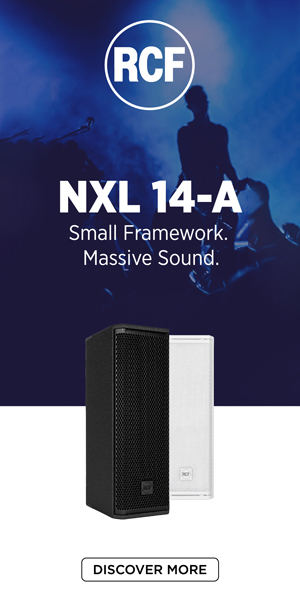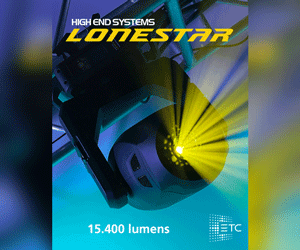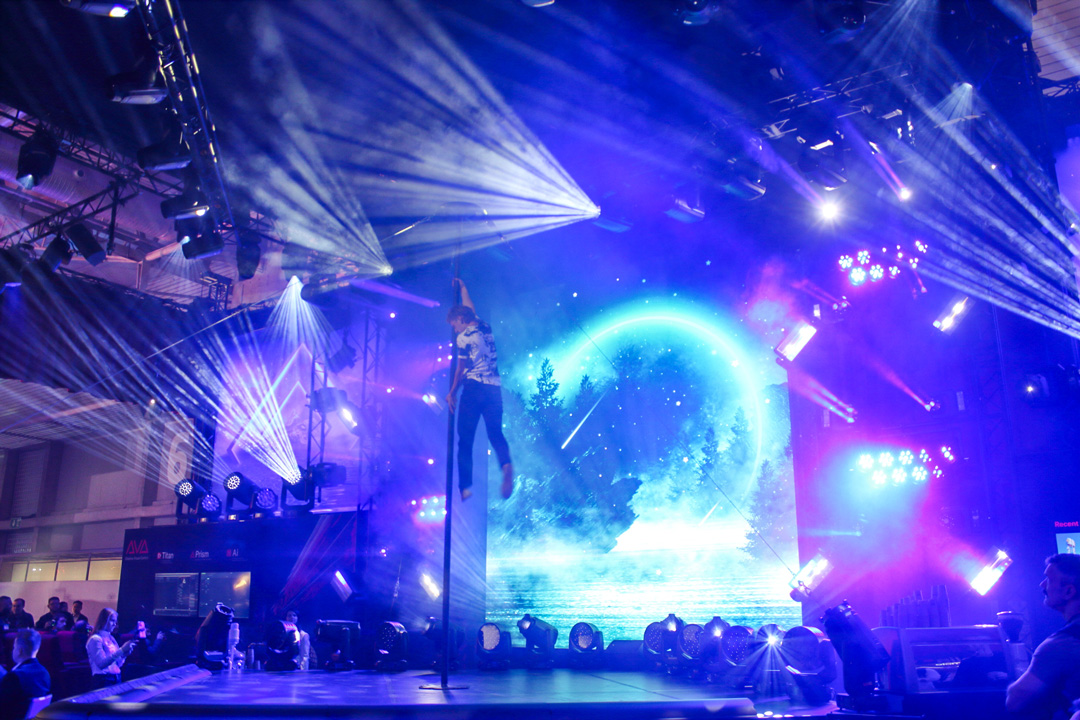
Robe is thinking big, with, for the first time at the show, a live show featuring their latest moving lights. Vincent Bouquet of Robe France gives us the details, while Josef Valchar, CEO of Robe, provides a more general overview of the group.
.
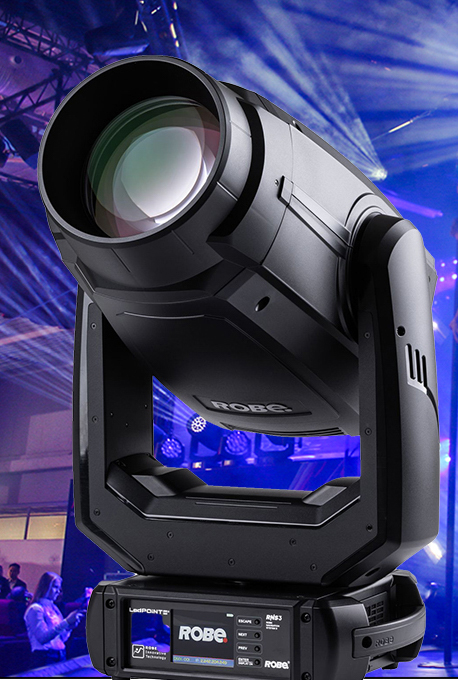
LedPointe
The fourth model of the Pointe range, this time equipped with a 280 W white LED source. Like the MegaPointe, it integrates a CMY trichromic system, a high-performance zoom variable between 1.8 and 44 ° aperture, and the patented “MLP” multi-level prism system allowing to superimpose several prisms while maintaining total control of their functions. The Spektrabeam multi-color effects engine introduced for the first time on the iBOLT is also included.
This new LedPointe is intended as a complementary fixture in the current range, its power and the impact of the beam being between the Pointe and the MegaPointe, with the advantage of its LED source (without a hot spot) which coupled with its palette of effects gives it greater flexibility of use and the homogenous spread of its beam whatever the zoom opening.
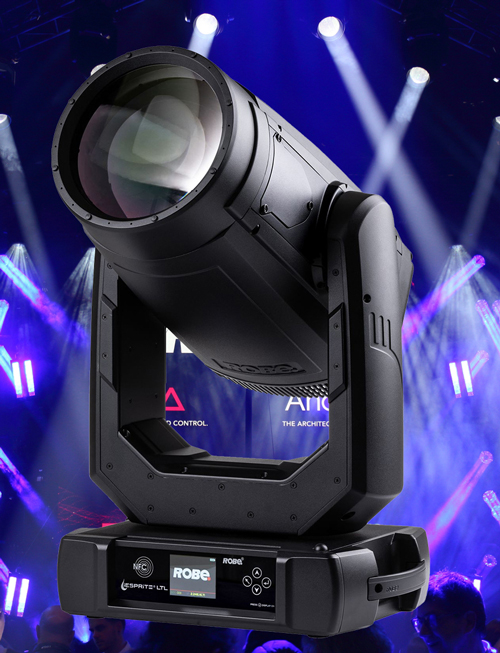
The iEsprite LTL
This fixture, whose development follows that of the Forte range, is the “long-throw IP” version of the Esprite. The first element to justify this name: is the zoom. At its narrowest, the beam opens to only three small degrees but still widens to 57°. Some internal modules of the classic iEsprite are no longer present, such as the servo-controlled framing shutters module, leaving more room for the beam to raise its power.
The iEsprite LTL still uses a CMY trichromic system, a progressive CTO two color wheels, two gobo wheels, one of which is rotating, an animation wheel, two prisms, an iris… so to speak, the main functions of a fixture made for “live” events.
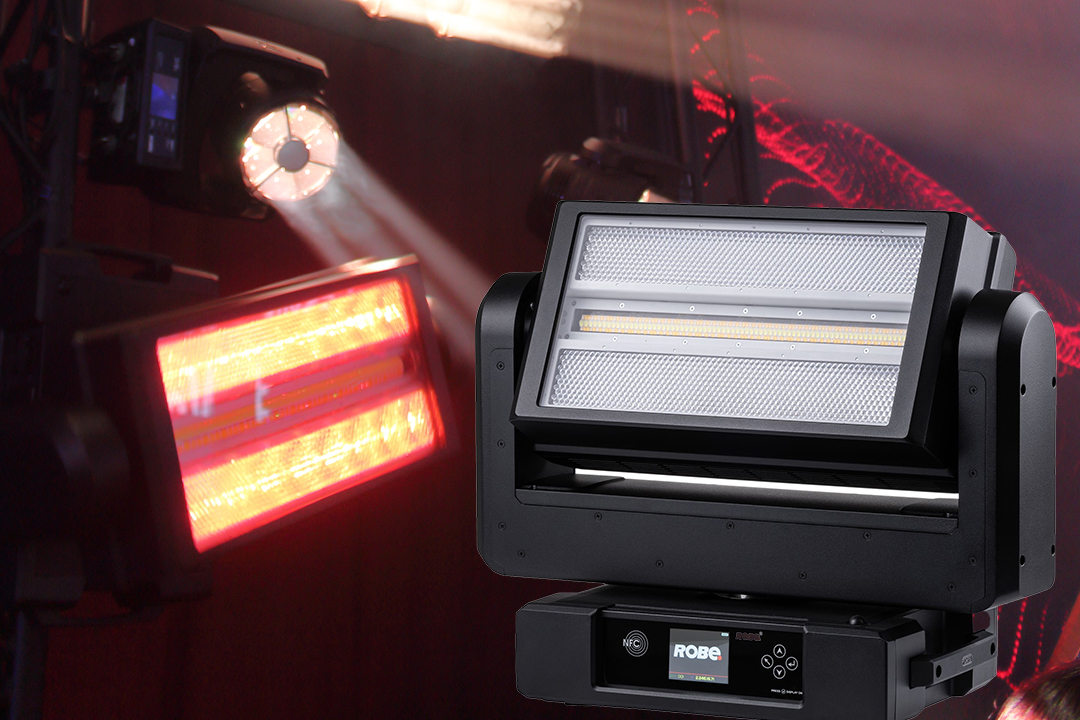
L’iStrobe
The first LED strobe fixture in the Robe range, the iStrobe, with its versatility, should quickly find its place in an already very competitive market segment. To begin with, it is IP65 and uses the same “Rains” technology as the iForte for example, with dehumidifier tubes placed in the arms of the device.
The pan/tilt axes have continuous rotation control. The head of the fixture integrates two wash zones that surround a central light “pencil/tube”: the wash parts are each composed of 8 RGBW LED matrices of 60 W for a total of 16 pixels.
Big news, two independent zooms manage the aperture of the beam emitted by the two Wash parts from 13 to 99 ° and a 3rd zooms the central pencil from 98 ° x 14 ° to 125 ° x 97 °. The physical movement of their lens which does not exceed 1 cm is very fast. The Central Zone is composed of a pencil of 72 white LEDs (6500 K) of 20 W controllable in 12 zones intended for the strobe function, and 1000 W of LEDs in warm white and amber for a blinder function from 1800 K to 3200 K with tungsten emulation. The presence of the zoom for this zone thus makes it possible to create a central blade of light.
These fixtures, some of which are already in production, will be available during the first half of 2025.
.
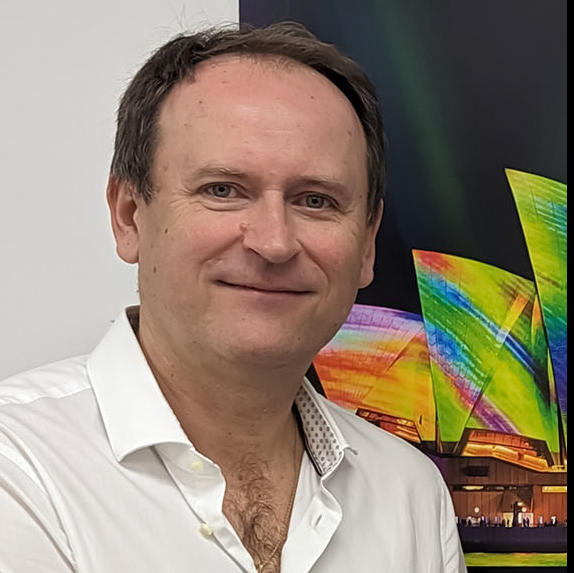
Interview with Josef Valchar
It was during his last visit to Paris a few days before the ISE that Josef Valchar, CEO and CTO of Robe, agreed to answer a few questions about his development choices.
SLU : Following the launch of the new LedPointe at LDI, how does this new luminaire compare to the MegaPointe, one of Robe’s bestsellers?
Josef Valchar : It’s a new member of the Pointe family, along with the miniPointe, the Pointe, and the MegaPointe. These three fixtures use gas discharge lamps and are still in production; the MegaPointe in particular is still in high demand. The use of the LED engine became necessary to integrate into certain state-funded projects for which gas discharge lamps are no longer permitted. That said, you don’t get the same efficiency or beam intensity from an LED engine. While the lamp allows us to reach 2 million lux at 5 meters with the MegaPointe, with LEDs we are at 170,000 lux. On the other hand, there is no hot spot created by a short-arc lamp. So it’s completely different.
SLU : What type of use do you recommend for this new fixture?
Josef Valchar : For beam effects, outdoors or in arenas, it is better to choose the MegaPointe, but indoors with a throw distance of 20 to 50 meters, the LedPointe is sufficient because it produces the same beam effects and in wide beam the rotating and static gobos are magnificent. It is therefore a versatile product, which is at the same time a spot, a beam, a wash, and an effects luminaire. We call it “all in one” because we designed it to be very good in each of these categories and without compromise.
From an optical point of view, it is similar to that of the MegaPointe with almost the same zoom range and the same gobo system, although they have evolved. This fixture has the same color system, which was crucial, and an identical effects engine with overlapping prisms. It also has the patented SpektraBeam system, which is present in the IBolt and produces a beam effect of different colors. The LedPointe also has the Transferable Engine technology.
SLU : Is it certified IP65?
Josef Valchar : It is IP 20 because an IP65 certification would have increased the price and we wanted to keep it affordable, but it is a possible improvement that could be decided based on feedback from our users. We started shipping the products in January and they will be on the market soon.
SLU : Why didn’t you choose to use a laser source?
Josef Valchar : We could have done it 2 or 3 years ago, but we refrained because the regulations seem insufficient to us. No one really knows how to use these laser sources, which can be dangerous for the eyes. The market does not seem to be trained yet in the safe use of this type of source, even at trade shows. I often prefer to stay away so as not to damage my eyes when narrow beams are projected at short distances. Moreover, if someone is injured in a country like the United States, it can cause a company to close.
This is why we preferred to reserve a laser source in the iBOLT, which is a fixture designed for very long distances to which we have added a safety device that measures the distance in real time. It was specially designed to protect technicians who could be exposed during installation, programming, or rehearsals because we assumed that the crews involved were not necessarily trained specifically for these sources. Europe is not as strict as the United States and the FDA in this regard. In fact, it took us a year to manage all the administrative work required to obtain the exemption allowing us to operate the iBOLT at the LDI in Las Vegas. Today, this exemption must be used by every company using it.
SLU : How does this special protection system work?
Josef Valchar : If you walk in front of this system, which can measure up to 100 meters away, the output is immediately cut off. Of course, this does not solve all the problems and it is also necessary to define a safe working space, where the beam can be directed when it is wide and therefore safe. The light impact in this case is much lower and I could even say that the beam becomes as safe as that of an LED source”.
The use of magnesium alloy for the covers of the iForte, an IP65 device, has been questioned. As a reminder, it is widely used in many industries, such as the automotive and aerospace industries, to manufacture various parts and, to a lesser extent, professional camera casings.
SLU : Will you continue to use magnesium alloy for the iForte’s covers?
Josef Valchar : “We designed the iForte to be IP65. But we also wanted it to resemble the Forte in terms of performance, shape, and weight. Ultimately, I think for 99% of people, there’s no visual difference between the Forte and the iForte. Using aluminum alloy for the covers would have made them nearly 40% heavier. That being said, the iForte’s frame and structure are still made of aluminum alloy to maximize strength, and this decision has had very positive feedback.
For us, generally speaking, it is important not to go faster than the buying and selling cycle of second-hand goods and to respect the investments made by service providers so that they do not lose value. This is possible as long as there is no replacement and for us, this is the number 1 priority. That said, the long life of the products and the options that make them sustainable can also work against us, and therefore, even if I try to commit to 7 to 10 years before releasing a new product, I am also careful not to weaken the brand. We are closely monitoring the market.
SLU : Since Robe acquired Avolites in June 2023, what have you already implemented and what are your short and medium-term plans?
Josef Valchar : We’re focused on developing new consoles. The Avolites D9 is the flagship product, and the D7 has joined it in a very interesting market segment. Its size, performance, and price range already make it a game-changer. Indeed, it’s easy to upgrade from a D9 to a D7 because both consoles use the same Titan software. In fact, the same Titan software runs on the Arena and Tiger Touch, even if their hardware becomes obsolete after a while.
SLU : Is it important to have smaller consoles in the range?
Josef Valchar : We believe that small consoles can be a good starting point for learning how to work with Avolites and then moving on to the D7 or even directly to the D9, the flagship product. New developments are due to come out towards the end of the year and concern a new console that will be placed below the D7. Furthermore, we also have ambitions to develop a media server that will be managed from the console. It may not be very visible at the moment, but the results are there and the whole thing is very powerful. It’s a bit like the hidden giant that is slowly growing.
This will be another step in bringing Avolites to where the brand should be in terms of reputation and results, that is to say, where it was 20 years ago and therefore before other companies developed. We manufacture fixtures that need to be controlled. We are therefore aware of the needs and the challenges. The UK team has 12 people in R&D and 60 in total at Avolites and they are ready to meet user needs.
SLU : Have you considered relocating Avolites to the Czech Republic, where Robe’s headquarters are located?
Josef Valchar : We’ve never had this thought because “made in the UK” has value. Since Avolites is a British company, it must remain in Great Britain. When we bought it, we became the owners of two buildings. Given the current real estate market in the UK, it’s more advantageous for us to carry out renovations little by little rather than moving. This is, in fact, the approach we chose for the Robe Factory in the Czech Republic. Furthermore, it allows us to remain free from banks that could curb our ambitions in the event of an economic crisis.
SLU : Are there any notable differences in terms of corporate culture between Robe and Avolites?
Josef Valchar : It’s a different country, language, and culture, but there are also many similarities. I think we have a passionate team in the UK, and we need to work together. Avolites has been in the market for almost 50 years, and of course, it takes time to understand the internal processes and help evolve to get them where we would like them to be. But we are definitely on the right track to impact the market with new products.
We have already evolved the distribution network, which is now managed by Robe in the US, Germany, France, and the Middle East, or by our distributors, with the exception of Singapore. The same is happening with LSC Control Systems, based in Melbourne, Australia. It’s a company specializing in power distribution racks, which Robe acquired last year. They also manufacture small entry-level consoles that don’t compete with Avolites, but also DMX interfaces, Artnet, DMX DALI, DMX splitters, etc. With these many gateways created, we are now present in power supply, lights, and control”.
More information on the Robe Lighting website

